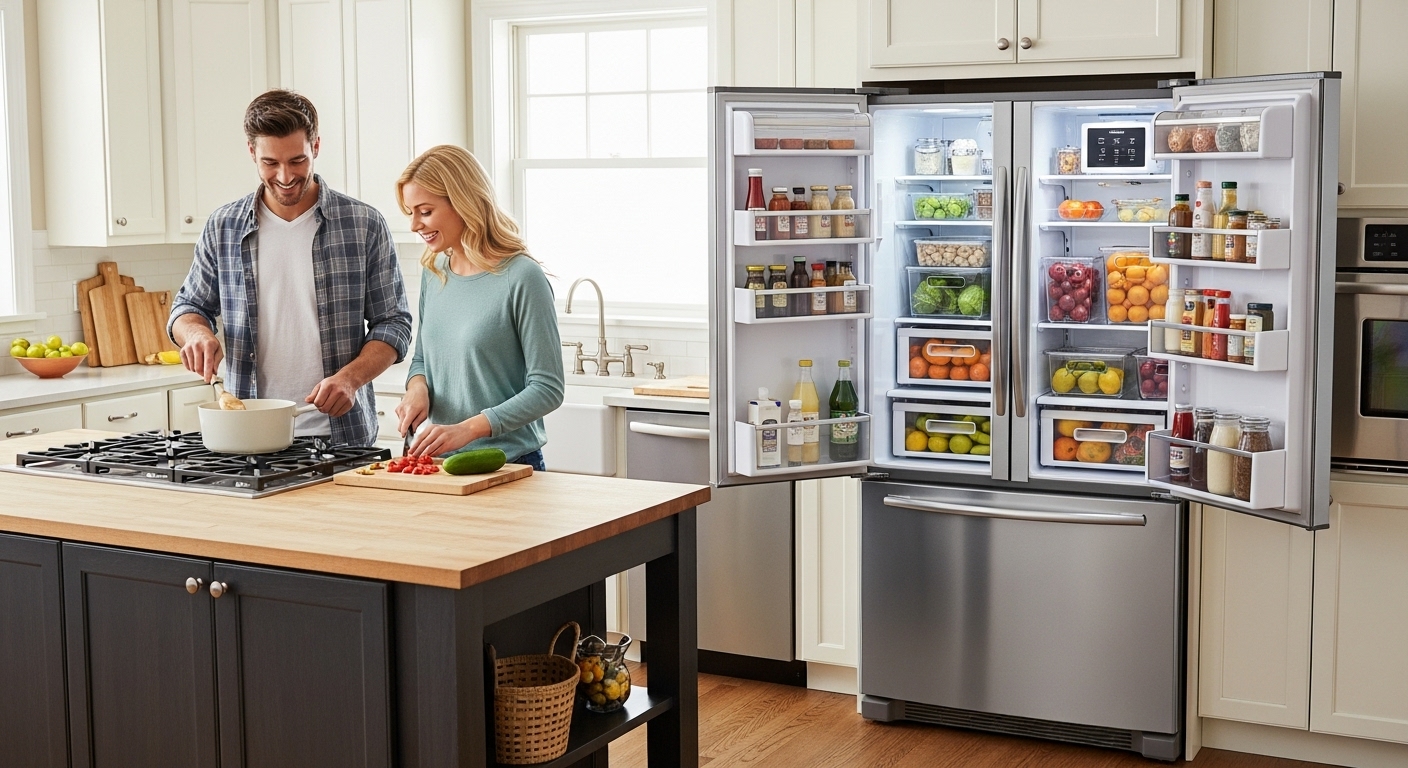Transform Your Fridge into an Efficient Food Storage System
A well-organized refrigerator is more than just aesthetically pleasing—it reduces food waste, saves time, prevents cross-contamination, and makes meal preparation significantly easier. Refrigerator organizer bins are simple yet transformative tools that can revolutionize how you store and access food. Whether you’re dealing with a cramped apartment fridge or a spacious French door model, the right organizational system can maximize every inch of space while keeping food fresh and visible.
Why Refrigerator Organizer Bins Matter
The average household wastes hundreds of dollars annually on spoiled food that gets pushed to the back of the refrigerator and forgotten. Organizer bins solve this problem by creating designated zones for different food types, making everything visible and accessible. When you can see what you have at a glance, you’re less likely to buy duplicates or let food expire unused.
Beyond reducing waste, organizer bins improve food safety by preventing cross-contamination between raw meats and ready-to-eat foods. They make cleaning easier since you can remove an entire bin to wipe down shelves rather than moving individual items. For families with multiple members accessing the refrigerator, bins create a system everyone can understand and maintain.
Organizer bins also maximize usable space. By utilizing vertical space with stacking bins and creating defined zones, you effectively increase your refrigerator’s storage capacity without buying a larger appliance.
Types of Refrigerator Organizer Bins
Clear Plastic Storage Bins
Clear plastic bins are the most popular choice for refrigerator organization. Their transparency allows you to see contents at a glance without opening the bin, which is crucial for maintaining temperature efficiency and quickly locating items.
These bins come in various sizes, from narrow containers perfect for holding yogurt cups or condiment bottles to wide bins ideal for storing lunch meat packages or cheese blocks. The best clear bins are made from BPA-free, food-safe plastic that won’t crack in cold temperatures.
Look for bins with smooth interiors that are easy to clean and won’t trap food particles in corners or crevices. Rounded corners are preferable to sharp angles for easier cleaning. Some clear bins feature built-in handles that make them easy to pull out like drawers, which is especially helpful for bins stored toward the back of deep shelves.
Wire Baskets
Wire baskets offer excellent visibility and air circulation, making them ideal for storing fruits and vegetables that benefit from air flow. The open design allows you to see everything from above and from the sides, and they’re incredibly easy to clean—many are even dishwasher safe.
Wire baskets work particularly well for storing produce that doesn’t require the high humidity of crisper drawers, such as bell peppers, cucumbers, or berries. They’re also excellent for organizing drink bottles since the wire structure prevents items from rolling around.
The main consideration with wire baskets is that small items can fall through the gaps. They’re best used for larger items or paired with a liner for smaller foods. Coated wire baskets are preferable to bare metal, as the coating prevents rust and is gentler on food packaging.
Stackable Bins
Stackable bins maximize vertical space, which is often underutilized in refrigerators. These bins are designed to nest securely on top of each other without tipping or sliding. They’re perfect for storing items you access less frequently on upper levels while keeping everyday items easily reachable on lower levels.
When using stackable bins, place heavier items on lower levels and lighter items above. Store less frequently used items like backup condiments or special occasion ingredients in upper bins, with everyday items in bottom bins. Ensure bins stack securely—wobbling stacks can lead to spills and frustration.
Stackable bins work best for packaged items rather than loose produce or liquids. They’re ideal for organizing yogurt containers, juice boxes, snack packs, or canned beverages. Look for stackable designs with interlocking features or textured surfaces that prevent slipping.
Lazy Susan Turntables
Lazy Susan turntables aren’t technically bins, but they’re invaluable organizational tools for refrigerators. These rotating platforms make items stored at the back of shelves easily accessible with a simple spin. They’re particularly useful in deep refrigerators or corner areas that are difficult to reach.
Turntables work wonderfully for condiments, jars, bottles, and small containers that tend to get lost in the back of shelves. They prevent the frustration of having to remove multiple items just to reach something behind them. Most refrigerator-specific turntables are made from clear plastic with raised edges to prevent items from sliding off during rotation.
Size matters with turntables—measure your shelf depth and width before purchasing to ensure the turntable fits properly and can rotate freely. Some refrigerators have shelves with lips or grooves that may interfere with rotation, so check your specific layout.
Egg Holders
Dedicated egg holders are often overlooked but highly practical. While eggs can stay in their original carton, specialized egg holders offer several advantages. They protect eggs from absorbing odors from other foods, stack efficiently to save space, and many designs make it easy to see how many eggs remain.
Some egg holders include date markers so you can track freshness. Others have lids to provide extra protection and prevent shells from absorbing refrigerator odors. Stackable egg holders are particularly useful for households that buy eggs in bulk.
The debate over refrigerator door versus shelf storage for eggs continues, but most food safety experts recommend storing eggs on a shelf where temperature is more consistent rather than in the frequently opened door.
Beverage Holders and Can Dispensers
Beverage organizers come in various designs, from simple can holders that stack cans horizontally to sophisticated dispensers that automatically rotate cans forward as you remove one. These organizers are excellent for households that buy canned beverages in bulk.
For bottled beverages, look for bins with dividers that prevent bottles from rolling around and clinking together. Some designs hold bottles on their sides to maximize space, while others keep bottles upright for easy identification.
Wine bottle holders designed for refrigerators stack bottles securely and efficiently. If you regularly chill wine, these specialized holders prevent bottles from rolling and make better use of shelf space than simply laying bottles down.
Produce Bins
While refrigerators come with crisper drawers, additional produce bins can be useful for organizing different types of produce or for storing produce on shelves if your crisper drawers are full. Some produce bins have vented lids that allow ethylene gas to escape, which helps fruits and vegetables stay fresh longer.
Produce bins with adjustable air vents give you control over humidity levels, which is important since different produce types have different storage needs. Leafy greens prefer high humidity, while fruits like apples do better with more air circulation.
Look for produce bins that are easy to clean, as produce can leave residue or moisture. Clear or semi-transparent designs help you monitor freshness without opening the container.
Drawer Organizers
Small drawer organizers designed specifically for refrigerator drawers help categorize items within your crisper and deli drawers. They’re perfect for separating different cheese types, organizing small condiment packets, or keeping snack-sized items neat and accessible.
These organizers prevent the jumbled mess that often accumulates in refrigerator drawers. By creating compartments, they make it easy to find specific items quickly and maintain order even when multiple family members access the drawer.
Adjustable dividers are particularly versatile, allowing you to customize compartment sizes based on what you’re storing. Look for organizers that fit snugly in your drawers without sliding around when you open and close them.
Choosing the Right Bins for Your Needs
Assess Your Refrigerator Layout
Before purchasing organizer bins, carefully measure your refrigerator’s interior. Measure shelf depths, widths, and heights, noting any obstructions like lights, vents, or irregular shapes. Refrigerator shelves are often slightly curved or have lips that affect what will fit.
Consider how your refrigerator door opens and whether bins will interfere with door storage compartments. Some bins are too deep or too wide and prevent the door from closing fully or block door-mounted items.
Take note of adjustable versus fixed shelves. If your shelves can be repositioned, you have more flexibility in choosing bin heights. Map out where different bin sizes would work best before shopping.
Consider Your Food Storage Habits
Think about what you typically store and how you shop. If you buy in bulk, you’ll need larger bins for storing multiples of the same item. If you prefer fresh produce shopping multiple times weekly, smaller produce bins might suffice.
Families with specific dietary needs or multiple household members might benefit from designated bins for each person or dietary category. A bin labeled for each family member’s lunch items, for example, streamlines morning routines.
Consider your cooking habits too. If you meal prep, bins for prepped vegetables, marinated proteins, or portioned snacks keep prepared foods organized and ready to use.
Prioritize Quality Over Quantity
It’s tempting to buy numerous inexpensive bins, but quality matters in refrigerator organization. Cheap plastic can crack in cold temperatures, develop odors over time, or contain harmful chemicals. Invest in fewer high-quality bins that will last years rather than many cheap ones you’ll need to replace frequently.
Look for bins made from BPA-free, food-grade materials explicitly rated for refrigerator use. Check product reviews for mentions of cracking, odor retention, or warping. Quality bins maintain their shape and clarity even after repeated washing.
Good handles are worth the extra cost. Bins stored on deep shelves or in the back of the refrigerator need sturdy, comfortable handles for easy pulling. Integrated handles that don’t add extra width are preferable to external handles that take up valuable space.
Start with Basic Categories
Rather than buying everything at once, start with bins for your most problematic areas. Most households benefit from organizing these categories first: dairy products like milk, cheese, and yogurt; deli meats and cheeses; beverages; produce that doesn’t fit in crisper drawers; condiments; and leftovers.
Once you’ve organized these high-traffic categories, assess whether additional bins would help with specific storage challenges. You may find that a few well-placed bins solve most of your organizational issues.
Setting Up Your Refrigerator Organization System
Zone Your Refrigerator
Effective refrigerator organization follows food safety principles and natural usage patterns. The top shelf should house ready-to-eat foods like leftovers, drinks, and prepared foods since it’s the warmest area. Middle shelves are ideal for dairy products, eggs, and items used frequently. Lower shelves should store raw meat, poultry, and fish, as this is the coldest area and prevents drips from contaminating other foods.
Door storage should be reserved for the most temperature-stable items like condiments, pickles, and drinks since the door experiences the most temperature fluctuation. Crisper drawers are designed for produce, with one drawer for high-humidity vegetables and one for low-humidity fruits.
Organize bins according to these zones. Place meat and fish bins on the bottom shelf with high sides to contain any leaks. Dairy bins work well on middle shelves. Beverage bins can go on upper shelves or in the door depending on what you drink most frequently.
Create a System Everyone Can Follow
The best organization system is one that’s intuitive enough for everyone in your household to maintain. Use clear bins so contents are obvious without opening them. Consider adding labels if you have many similar-looking bins or if household members have trouble maintaining organization.
Label options include removable vinyl labels, erasable labels, or simple masking tape and marker for flexibility as needs change. Labels should indicate contents rather than specific brands—”Cheeses” rather than “Cheddar, Mozzarella, etc.”
Position frequently accessed items in easy-to-reach locations. Kids’ snacks should be at their eye level in a dedicated bin they can access independently. Items used daily should be front and center, while backup or occasional-use items can be stored toward the back or in less convenient spots.
Maximize Vertical Space
Most people use only the horizontal space in their refrigerators, leaving vertical space unused. Stackable bins or risers allow you to create a second level of storage on deep shelves. This approach works particularly well for canned beverages, yogurts, or condiments.
Some creative organizers use small, stackable platforms to create tiers within bins, displaying items at different heights for better visibility. This theater-style arrangement ensures nothing hides behind taller items.
Be mindful not to block air vents when stacking items or bins. Refrigerators need air circulation to maintain even temperatures throughout, and blocked vents can create warm spots or force the appliance to work harder.
Implement the “First In, First Out” System
Reduce food waste by organizing bins so older items are accessible first. When adding new groceries, place them behind or under existing items of the same type. This ensures you use older food before it expires.
This system works particularly well in bins dedicated to specific item types. A yogurt bin, for example, makes it easy to arrange containers by date. When reaching for yogurt, you naturally grab from the front where the oldest containers are positioned.
Date labeling helps with first-in, first-out organization. Mark containers with purchase or opening dates, especially for items without visible expiration dates like leftovers or opened packages.
Maintaining Your Organized Refrigerator
Weekly Maintenance
Set aside time weekly to maintain your organization system. This doesn’t need to be time-consuming—a quick five-minute review makes a significant difference. Remove any expired items, wipe up spills or drips in bins, and reorganize items that have been displaced during the week.
Check that items are in their designated bins. Over the course of a busy week, things naturally migrate. Return misplaced items to their proper locations to maintain the system.
Do a visual inventory during your weekly maintenance. This helps with meal planning and grocery shopping, preventing you from buying items you already have while ensuring you don’t run out of essentials.
Deep Cleaning Schedule
Even with bins, your refrigerator needs periodic deep cleaning. Monthly or bi-monthly, remove all bins and wash them thoroughly with warm, soapy water. This prevents buildup of food residue, bacteria, or odors.
While bins are out, wipe down refrigerator shelves and walls. This is much easier with bins removed than trying to clean around everything. Check for spills or leaks that may have occurred beneath or behind bins.
Dry bins completely before returning them to the refrigerator to prevent excess moisture that can accelerate spoilage or create ice buildup. This is also an opportunity to reassess whether your bin configuration is working or needs adjustment.
Adjusting Your System
Don’t be afraid to modify your organization system as your needs change. Seasonal eating patterns, household changes, or new shopping habits may require different bin configurations. What works in winter when you’re storing hearty root vegetables may not work in summer when you’re buying more fresh fruits.
If you find certain bins consistently remain empty or are always overflowing, adjust sizes or reassign purposes. An effective organization system evolves with your lifestyle rather than remaining rigidly fixed.
Common Mistakes to Avoid
Over-organizing
It’s possible to have too many bins, creating a system so complex that it’s difficult to maintain. If you’re spending more time organizing than you’re saving in efficiency, you’ve overcomplicated things. Start simple and add complexity only if needed.
Too many small bins can be as problematic as no organization. They can make it difficult to fit larger items and create more surfaces that need cleaning. Aim for the minimum number of bins that effectively organize your space.
Blocking Air Circulation
Refrigerator air vents need clear space around them to circulate cold air effectively. Don’t place bins directly against vents or pack bins so tightly that air can’t flow between them. Leave some space between bins and between bins and walls for proper air circulation.
Overcrowding bins themselves also restricts air flow around individual food items. Bins should be full enough to be useful but not so packed that air can’t circulate around contents. This is particularly important for produce, which needs air flow to stay fresh.
Choosing Style Over Function
Aesthetic organization trends on social media can be inspiring, but prioritize function over appearance. A picture-perfect refrigerator filled with matching containers for everything might look beautiful but may not be practical for your actual lifestyle and food storage needs.
Decanting everything into uniform containers, for example, removes helpful information like expiration dates, cooking instructions, and ingredient lists. It also creates extra dishes to wash and can lead to confusion about what’s actually in each container. Choose aesthetically pleasing bins that also work practically for your needs.
Ignoring Temperature Zones
Even with bins, food placement matters for safety and freshness. Don’t store raw meat in top-shelf bins just because that’s where space is available. Follow proper food safety guidelines about which foods belong on which shelves regardless of your bin organization.
Similarly, don’t store temperature-sensitive items like milk or eggs in the door just because you have a nice bin that fits there. Door storage experiences the most temperature fluctuation and is unsuitable for highly perishable items.
Budget-Friendly Organization Options
Quality refrigerator bins can be expensive, but budget-friendly options exist. Dollar stores often carry basic clear bins suitable for refrigerator use at a fraction of specialty organizer prices. While they may not have all the features of premium bins, they function well for many purposes.
Repurpose containers you already own. Food storage containers, takeout containers, or even sturdy cardboard boxes can serve as temporary organizers while you determine what permanent solutions work best. This try-before-you-buy approach prevents purchasing bins that don’t fit your needs.
Shop secondhand stores for bins and organizers. Many thrift stores have organization sections where you can find barely used bins at low prices. Just ensure any secondhand bins are thoroughly cleaned and sanitized before use with food.
Consider gradually building your collection. Rather than purchasing a complete organization system at once, buy one or two bins at a time as budget allows. This gradual approach also lets you refine your system based on what actually works rather than committing to a full system upfront.
The Bottom Line
Refrigerator organizer bins are simple tools that deliver significant benefits. They reduce food waste, save money, improve food safety, and make daily life more convenient. The key to success is choosing bins appropriate for your specific refrigerator dimensions, food storage habits, and household needs.
Start with basic organization for your most problematic areas, then expand your system as needed. Prioritize quality bins that will last, and create a system simple enough for everyone in your household to maintain. With a well-organized refrigerator, you’ll waste less food, spend less time searching for items, and enjoy a more efficient, pleasant kitchen experience.
The investment in refrigerator organizer bins—whether $20 or $200 depending on your approach—pays for itself quickly through reduced food waste alone. More importantly, it transforms one of your most-used appliances from a source of frustration into an efficient, organized system that supports healthier eating and a more functional home.



